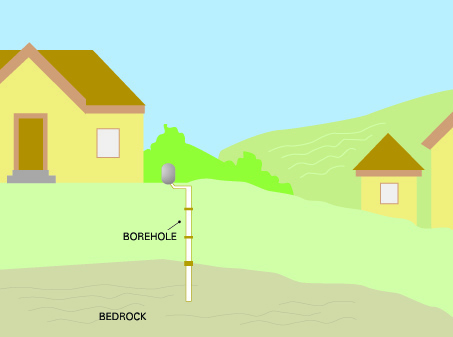Uranium in your drinking water may be harmful to your health. The U.S. Environmental Protection Agency (EPA) has determined that safe drinking water should contain less than 30 parts per billion (ppb) uranium. The amount of uranium in public drinking water is regulated under federal law by EPA standards. If your water comes from a public system, it is routinely tested to ensure safe levels of uranium. If your source of household water is a private well, cistern or spring, you are solely responsible for the quality of your own drinking water. Private well owners are encouraged to monitor uranium through water testing.
Uranium occurrence and exposure
Uranium is a radioactive element that can be naturally present in some rocks and ground-water. A small number of public and private water systems in the Southeastern U.S. exceed the EPA drinking water standard for uranium. In Georgia, these water systems are located primarily in the northern part of the state (above the “Fall Line”) and are generally supplied by wells deeper than 100 feet in granitic bedrock. Levels of uranium above 30 ppb have not been found in shallow wells or surface water.
According to the Agency for Toxic Substances and Disease Registry report (1995), drinking from a uranium-contaminated water supply is the most likely route of exposure. Skin contact is not considered harmful to health.

What potential health concerns are associated with uranium ingestion?
Studies suggest that drinking water with uranium levels above 30 ppb may increase the risk of kidney malfunction. Exposure to uranium in drinking water has not been shown to increase the risk of developing cancer.
This publication is not a substitute for professional medical advice. Consult your physician if you have any questions or concerns related to the potential health effects from consuming water containing uranium.
What should I do if my water contains excessive levels of uranium?
You should not continue to drink water contaminated with excessive levels of uranium. You may, however, continue to bathe, wash clothes or even water your garden.
Affordable home water-treatment options are available, such as “point-of-use” reverse osmosis (RO) systems that produce 5 to 20 gallons of drinkable water per day and remove 90-99% of uranium. Point-of-use RO systems validated and certified by an authorized body are available from many manufacturers. More information may be obtained from the National Sanitation Foundation (NSF) at https://info.nsf.org/Certified/dwtu/ or Water Quality Association (WQA) at https://www.wqa.org. After installing any home water treatment system for uranium removal, you should retest your water. Periodic maintenance of the treatment system, as instructed by the manufacturer, is recommended to ensure proper function and safety.
 A “point of use” reverse osmosis system can be used to remove uranium.
A “point of use” reverse osmosis system can be used to remove uranium.
NOTE: Elevated concentrations of uranium in well water often indicate high levels of radon in both well water and in the home’s indoor air. It is recommended that well owners with elevated uranium levels also test their well water and home for radon gas. To test air in your home, you can obtain a radon test kit from your local UGA county Extension office (1-800-ASK-UGA-1).
Sources
Agency for Toxic Substances and Disease Registry. (1999). Toxicological profile for uranium (update). U.S. Public Health Service.
Butler, A. H., & Kahn, B. (1995). Radon-222, radium-226, and uranium in Georgia Piedmont well water. Proceedings of the Georgia Water Resources Conference (1995), 401–404.
Centers for Disease Control (CDC). (2022). Chemicals That Can Contaminate Tap Water: Radon. https://www.cdc.gov/healthywater/drinking/contamination/chemicals.html#radon
Orloff, K.G., Mistry, K., Charp, P., Metcalf, S., Marino, R., Shelly, T., Melaro, E., Donohoe, A. M., & Jones, R. L. (2004). Human exposure to uranium in groundwater. Environmental Research, 94, 319–326. https://doi.org/10.1016/S0013-9351(03)00115-4
U.S. Environmental Protection Agency (EPA). (2000). National primary drinking water regulations: Radionuclides. Final Rule. Federal Register 76780-76753, 7 December 2000.
U.S. EPA. (2009). A citizen’s guide to radon: The guide to protecting yourself and your family from radon (Publication No. EPA 402/K-09/001). https://semspub.epa.gov/work/06/100000695.pdf
World Health Organization (WHO). Uranium in Drinking Water (update) 2005.WHO/EOS Geneva.
Additional Web Resources
Vermont Department of Health. https://www.healthvermont.gov/environment/drinking-water/gross-alpha-radiation-uranium-and-radium-drinking-water
University of Nebraska-Lincoln Extension. Institute of Agriculture and Natural Resources. https://water.unl.edu/
Status and Revision History
Published on Oct 28, 2010
Unpublished/Removed on Mar 01, 2015
Published with Minor Revisions on Aug 19, 2020
Published with Full Review on Nov 07, 2023


























































